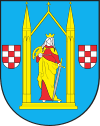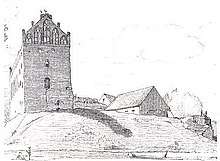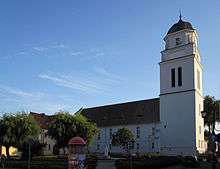Działdowo
Działdowo pronounced [d͡ʑau̯ˈdɔvɔ] (German: Soldau) is a town in north-central Poland with 24,830 inhabitants (2006), the capital of Działdowo County. As part of Masuria, it is situated in the Warmian-Masurian Voivodeship (since 1999), Działdowo belonged previously to Ciechanów Voivodeship (1975–1998). The town is a major railroad junction connecting the capital city of Warsaw with Gdańsk and Olsztyn to the north.
Działdowo | |
|---|---|
 .jpg)  
| |
 Flag  Coat of arms | |
 Działdowo | |
| Coordinates: 53°14′N 20°11′E | |
| Country | |
| Voivodeship | Warmian-Masurian |
| County | Działdowo County |
| Gmina | Działdowo (urban gmina) |
| Established | 14th century |
| Town rights | 1344 |
| Government | |
| • Mayor | Grzegorz Mrowiński |
| Area | |
| • Total | 13.35 km2 (5.15 sq mi) |
| Population (2006) | |
| • Total | 20,824 |
| • Density | 1,600/km2 (4,000/sq mi) |
| Time zone | UTC+1 (CET) |
| • Summer (DST) | UTC+2 (CEST) |
| Postal code | 13-200 |
| Area code(s) | +48 23 |
| Car plates | NDZ |
| Website | http://www.dzialdowo.pl |
History
The first settlement in the vicinity, known as Sasinowie in Polish and Sassen in German, was established by the Old Prussians, an indigenous Baltic tribe. The Teutonic Knights conquered the region and built a castle, a wing of which still remains. The new settlement near the castle founded by Mikołaj z Karbowa and named Soldov was granted town privileges on 14 August 1344 by the Grand Master Ludolf König. The name Dzialdoff was first written on a 1409 map during the Polish–Lithuanian–Teutonic War.[1]
.jpg)
After the outbreak of the Thirteen Years’ War in 1454, the town sided with Poland and recognized the Polish King as rightful ruler.[2] The town was briefly captured by the Teutonic Knights in 1455.[2] After the peace treaty signed in Toruń in 1466 it remained part of the State of the Teutonic Knights, now a Polish fief.
Within the Duchy of Prussia (a Polish fiefdom until 1657) the settlement converted to Lutheranism during the Protestant Reformation of the 16th century. The following communes belonged to the Protestant parish of Soldau: Amalienhof, Borowo, Bursch, Cämmersdorf, Gajowken, Hohendorf, Kyschienen, Königshagen, Kurkau, Niederhof, Pierlawken, Pruschinowo, and Rudolfsfelde.
Kingdom of Prussia and Germany
In 1701 the town became part of the Kingdom of Prussia, from 1773 on within the newly formed province of East Prussia. Within the Kingdom of Prussia and the later German Empire, the settlement developed into an important Prussian Eastern Railway junction in the second half of the 19th century.


The town had Polish majority in 1825 with 1496 Poles and 386 Germans living within it.[3] At the same time the Prussian authorities were hostile to the local population due to its Polish pro-independence activity during the November and January Uprisings in Congress Poland. During the January Uprising of 1863 an ammunition depot and contact point was secretly established by local people trying to help their fellow Poles in the struggle against the Russian Empire; it was located at the house of Doctor Russendorf.[4] Prussian authorities arrested several locals and harassed the local population which tried to form military units to aid the uprising.[5] The area remained Polish despite attempts at Germanisation. In 1815 79% of the local population were Poles, and only 21% Germans. In 1837 74% were Poles and 26% Germans. In the second half of the 19th century 87% of the district's population were Poles. With the increase of Germanisation efforts in 1910, the whole district population was divided among 57% Poles, 42% Germans and 1% Jews according to official German statistics.[5] In 1910 the town itself had 4,728 inhabitants, 3,589 of them Germans.[1] In 1912 the Germans introduced the terms "Masurs" and "Masurian language" instead of "Pole" and "Polish language" in the census in the area.[5] It was part of the Landkreis Neidenburg district in East Prussia, and it was the southernmost town in the province.
The town was fought over in the early stages of World War I. It was briefly occupied by Russian troops, and won back by the Germans during the Battle of Tannenberg. The occupation of Soldau is described in Aleksandr Solzhenitsyn's novel August 1914.
Interwar Poland
Despite the attempts of the local German populace and authorities and the German Government, the town together with neighboring settlements was transferred to the Second Polish Republic on January 17, 1920 by the Treaty of Versailles for geostrategic reasons without participating in the East Prussian plebiscite.[6] The Prussian Eastern Railway connection to German Prussia such as Deutsch Eylau (Iława), Osterode (Ostróda), and Neidenburg (Nidzica) in East Prussia were severed after the border changes. After the town was ceded to Poland, a large number of the German inhabitants left. The candidate of the German Party, Ernst Barczewski, was elected to the Sejm with 74.6% of votes in 1920,[7] and to the Polish Senate with 34.6% of votes for the Bloc of National Minorities in 1928.[7] In 1921, the Polish census gave the following data regarding the ethnic composition of the whole district: Poles, 15,496; Germans, 8,187; others, 44.[5]
During the Polish-Soviet War Działdowo was briefly occupied by the Red Army which was cheered as a liberator by the local populace, and the town hoisted the German flag again[8][9] but it was soon recovered by the Polish Army.
World War II

After the German Nazi - Russian Soviet invasion of Poland in 1939 that began World War II, the town was annexed back into the Neidenburg District by Nazi Germany. The German minority in the town formed the Selbstschutz death squad that captured and tortured Polish leaders and members of the political and cultural elites before murdering them.[4] The Soldau concentration camp was built nearby, at which 10,000–13,000 prisoners out of 30,000 were murdered.[1]
Działdowo was heavily damaged during the fighting on the Eastern Front. The destroyed town was restored to Poland after the war.
Notable residents
- Kasia Stankiewicz (born 1977), singer
International relations
Działdowo is twinned with Hersfeld-Rotenburg, Germany, and Truskavets, Ukraine.
References
- Marek Przybyszewski, IBH Opracowania - Zamek w Działdowie jako centrum administracyjne ziemi sasińskiej (Castle in Działdowo as Centre of Government). Archive, 22 October 2010.
- Słownik geograficzny Królestwa Polskiego i innych krajów słowiańskich, Tom II, Warsaw, 1881, p. 262 (in Polish)
- Stanisław Salmonowicz, Gerard Labuda, Kazimierz Ślaski (1993), Historia Pomorza: (1815-1850). Gospodarka, społeczeństwo. Page 163.
- Nasze miasto. Historia: Lata 1939 - 1945. Dzialdowo.pl (in Polish)
- Jerzy Łapo, History of Działdowo Virtual Shtetl 2014.
- Kossert, Andreas (2005). Ostpreussen, Geschichte und Mythos (in German). Siedler. pp. 283 ff. ISBN 3-88680-808-4.
- Kossert, Andreas (2006). Masuren Ostpreussens vergessener Süden (in German). p. 284. ISBN 3-570-55006-0.
74,6 Prozent der Soldauer Stimmen gingen an den Kandidaten der deutschen Soldauer Bewegung (...). Dennoch gelang Superintendent Barczewksi 1928 mit 34,6 Prozent der Stimmen der Einzug in den Warschauer Senat
- NY Times report: Russians Hoist the German Flag Over Soldau. August 16, 1920.
- Blanke, Orphans of Versailles
